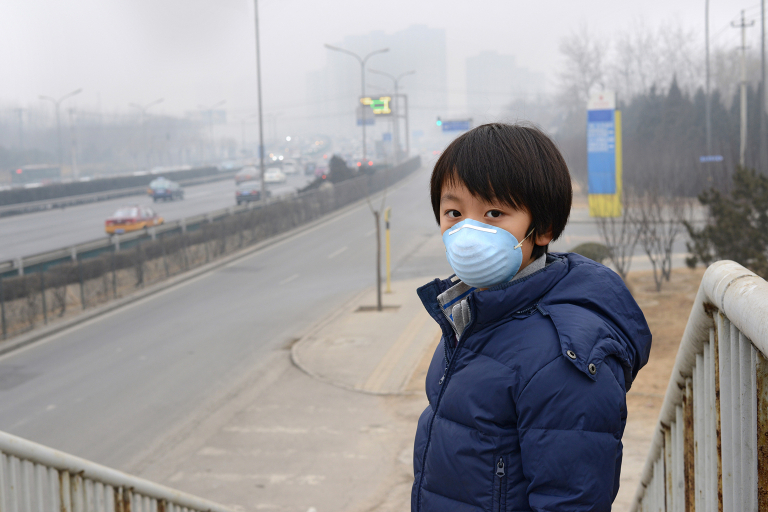Unhappiness tracks poor air quality in China

Image: Hung_Chung_Chih/IStock.com via AFP Relaxnews
Eye-watering, throat-scratching air pollution is a major driver of big city blues in China, according to a study published Monday that matched social network chatter with fine-particle pollution levels.
“The take-away is simple,” lead author Siqi Zheng, an associate professor at Massachusetts Institute of Technology (MIT) and director of the University’s China Future City Lab, told AFP. “Higher levels of air pollution lower people’s happiness in the world’s most populous country.”
Dirty air is not the only blight on life in urban China, which is also plagued by soaring housing prices, worries over food safety, and poor public services.
But health-wreaking pollution, especially microscopic bits from coal-fired power plants and factories that settle in the lungs, is a long-standing gripe of the country’s burgeoning middle class.
More than a million premature deaths every year in China can be chalked up to air pollution, the World Health Organization and other research groups have concluded.
A toxic cocktail of small and larger particulate matter, nitrogen dioxide (NO2), sulphur dioxide (SO2) and ozone (O3) is likewise linked to poor cognitive performance, labour productivity and educational outcomes.
On polluted days, people are also more likely to engage in impulsive and risky behavior they may later regret, observational studies have shown.
Awareness of the problem and its consequences is very high among China’s city dwellers, a fact not lost on the government.
After an embarrassing episode in 2012 when daily pollution levels published on Twitter by the United States embassy in Beijing were consistently higher than official figures for the city, China’s leaders declared war on smog-clogged air.
Happiness index
They set up hundreds of monitoring stations throughout the country, and introduced more stringent standards, especially for small particles less than 2.5 microns (PM2.5) in diameter.
The average human hair is 60-to-90 microns in width.
According to the new rules, the density of these dangerous microscopic particles should not exceed 35 microgrammes per cubic metre for any 24-hour period. WHO Air Quality Guidelines are even stricter, setting the limit at 25 microgrammes per cubic metre.
In China’s most heavily polluted cities, including Beijing and Tianjin, home to more than 35 million, particle density is often two, three and even four times higher than either standard.
To gauge how urban air pollution affected day-to-day mood, Zheng and colleagues used machine-learning algorithms to comb through more than 200 million messages from 144 cities posted in 2014 on Weibo, China’s largest microblogging site.
As of mid-2018, Weibo, similar to Twitter, had 455 million active users.
The researchers devised an “expressed happiness index” based on key words and context, and then stacked it up against fluctuating PM2.5 pollution levels.
“We found a significant negative correlation,” when one went up, the other went down, “between pollution and happiness levels,” Zheng said. “Women were more sensitive to higher pollution levels than men.”
Average daily PM2.5 concentration was 55 microgrammes per cubic metre across all 144 cities, more than double the WHO limit, and several times higher in many.
More than half of China’s population, nearly 700 million people, now lives in urban areas.
Intriguingly, the link was strongest in the cleanest and dirtiest cities examined.
People very worried about health and air quality tend to move to cleaner cities, the study suggested, while those in the dirtiest urban areas were more aware of damage to their health.
“Our index has the potential to become a tool for government to understand common citizens’ daily concerns,” Zheng said.
The Chinese government, in fact, has long monitored posts and conversations on social networks to track public opinion.
Since 2013, PM2.5 particle pollution has dropped on average about 40 percent, according to one recent study, but ground-level ozone pollution continues to climb.
A Chinese environment ministry official said Monday that PM2.5 density rose 9.2 percent year-on-year between Oct. 1 and Jan. 19 in the Beijing-Tianjin-Hebei area, according to the official Xinhua news agency.
China wants to slash PM2.5 density by three percent year-on-year between Oct. 1, 2018 and March 31, 2019 in the region, said the official, Liu Bingjiang.
Cities that miss air quality targets will be penalised with “accountability measures,” which have yet to be determined, he said. JB
RELATED STORIES:
Air pollution linked with increased number of visits to ER for breathing problems
Air pollution caused an estimated 4.5 million deaths in 2015, says new study